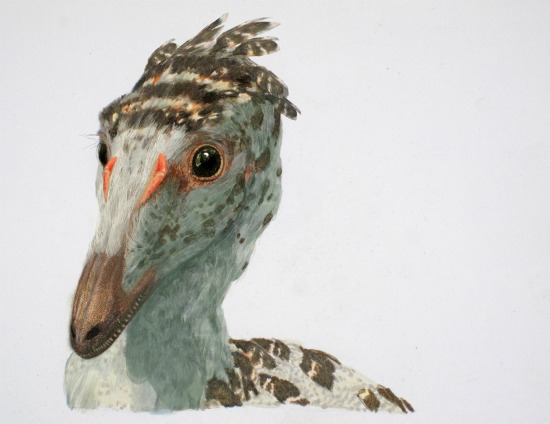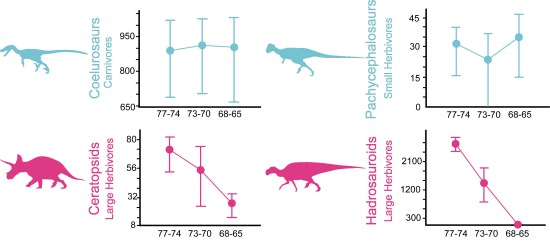May 1, 2012
New Wrinkle to the Story of the Last Dinosaurs
![]()

Small coelurosaurs like this Troodon appear to have maintained stable levels of disparity during the last 12 million years of the Cretaceous. Image courtesy AMNH/J. Brougham.
Why did the non-avian dinosaurs become extinct? There's no shortage of ideas, but no one really knows. And even though paleontologists have narrowed them down to a short list of extinction triggers—including an asteroid strike, massive volcanic outpouring, sea level changes and climate alterations—how these events translated into the extinction of entire clades of organisms remains hotly debated.
One of the most contentions questions is whether dinosaurs thrived right until the end of the Cretaceous, or whether they were already declining before the lights went out. Based on species counts, mostly from the roughly 66-million-year-old rock of western North America's Hell Creek Formation, it might seem that dinosaurs were not quite as diverse as they were in the same area 10 million years earlier. But detecting this decline depends on how species are identified and counted—a quirk affected by how we distinguish dinosaurs and other organisms known only from fossils. If we recognize that Triceratops and Torosaurus were separate dinosaur genera, for example, there were two big ceratopsids present in western North America at the end of the Cretaceous. But if we start from the position that the dinosaurs we call Torosaurus were really the skeletally mature form of Triceratops, then ceratopsid diversity is cut in half. And even the best circumstances, the fossil record is an imperfect catalog of prehistoric life that we are only sampling a few pieces from. Determining diversity by taking species counts is not as simple as it sounds.
In a Nature Communications paper published today, paleontologists Stephen Brusatte, Richard Butler, Albert Prieto-Márquez and Mark Norell take a different approach. Rather than track species and genera, the researchers followed trends in morphological disparity—how the forms of dinosaurs varied across seven major groups, both globally and regionally. Differences in form translate to differences in lifestyle and behavior, mostly avoiding tangled taxonomic arguments, and this technique gauges how many forms of dinosaurs were present at a given time. This is a proxy to detect which groups of dinosaurs might have been thriving and which were declining over time.

Disparity trends in four dinosaur groups during the final 12 million years of the Cretaceous (North American species only). Time (from 77-65 million years ago) is shown on the x axis. The y axis shows the disparity metric: sum of variances derived from anatomical character databases. The error bars indicate whether comparisons between time intervals are significant or not (overlap of error bars means non-significance, no overlap means significance). Overall, the large-bodied bulk-feeding ceratopsids and hadrosauroids underwent a marked long-term decline, but the carnivorous coelurosaurs and small herbivorous pachycephalosaurs were stable. (AMNH/S. Brusatte)
Brusatte and co-authors tracked disparity trends among ankylosaurs, sauropods, hadrosauroids, ceratopsids, pachycephalosaurids, tyrannosauroids and non-avian coelurosaurs during the last 12 million years of the Cretaceous (from the Late Campanian age to the Maastrichtian). There was no simple pattern that held true for all dinosaurs—some groups stayed the same while others declined. The heavily armored ankylosaurs, dome-headed pachycephalosaurs, formidable tyrannosaurs and small, feathery coelurosaurs didn't seem to show any major changes in disparity over this span. And the massive, long-necked sauropods showed a very slight increase in disparity from the Campanian to the Maastrichtian. Both locally and globally, these dinosaur groups were not dwindling away.
The shovel-beaked hadrosaurs and horned ceratopsids showed different trends. Horned dinosaurs suffered a significant drop in disparity between the Campanian and the Maastrichtian, at least partially attributable to the disappearance of an entire ceratopsid subgroup. During the Campanian, both centrosaurines (like Centrosaurus) and chasmosaurines (like Chasmosaurus) roamed North America, but by the Maastrichtian, only the chasmosaurines were left. And while hadrosaur disparity dipped slightly from a global perspective, the pattern differed between continents. In Asia, hadrosaurs appear to show very slight increases in disparity, but North American hadrosaurs suffered a sharp decline across the 12-million-year study range. What was true for North American dinosaurs was not necessarily true for the rest of the world.
"Compared with previous studies that focused on species richness or faunal abundance," Brusatte and colleagues write, "these disparity calculations paint a more nuanced picture of the final 12 million years of dinosaur history." The idea that dinosaurs, as a whole, were either thriving or declining is a false dichotomy. The last twelve million years were clearly a time of flux—especially in North America, where some dinosaur groups stayed stable but the largest, most abundant herbivores were not as varied as their predecessors had been.
That sauropod dinosaurs increased in disparity at towards the end of the Cretaceous is especially noteworthy. When I was a kid, sauropods were often cast as Jurassic titans that were replaced by dinosaurs with superior plant-shearing abilities, such as certaopsids and hadrosaurs. Yet sauropods hung on, and as the horned and shovel-beaked dinosaurs declined, sauropods might have again been expanding. We will never know what would have happened had the Cretaceous extinction been canceled. Although, if the non-avian dinosaurs had been given a reprieve from extinction, we almost certainly wouldn't have evolved to ponder what happened so long ago.
As this study points out, it is a mistake to think of dinosaurs as a monolithic group. The pressures behind dinosaur evolution, and the reasons for their extinction, varied from group to group and place to place. The more we learn about them, the more complex their history becomes. And there's still much we don't know. To date, most of what we think we understand about the extinction of the non-avian dinosaurs comes from western North America—relatively accessible sites that record the transition from the last days of the dinosaurs to a world dominated by mammals. These sites, no matter how well we study them, can only be a small part of what was a global extinction, and what we find in North America may not be representative of the rest of the planet. "It may be," Brusatte and collaborators write, "that the North American record represents a local anomaly," with "extreme fluctuations of the inland Western Interior Sea, mountain building, and proposed biogeographic provincialism" influencing dinosaur evolution in a unique way not seen on other continents.
If we want to understand the evolution and extinction of the last dinosaurs, we need to take a more refined, localized approach and not think of dinosaurs as a uniform group. For as much ink has been spilled about dinosaur evolution and extinction, we are still only beginning to piece together a picture of what the final days of the Cretaceous were like.
Reference:
Brusatte, S., Butler, R., Prieto-Márquez, A., Norell, M. (2012). Dinosaur morphological diversity and the end-Cretaceous extinction Nature Communications : 10.1038/ncomms1815
http://blogs.smithsonianmag.com/dinosaur/2012/05/new-wrinkle-to-the-story-of-the-last-dinosaurs/?utm_source=feedburner&utm_medium=feed&utm_campaign=Feed%3A+smithsonianmag%2FDinosaur+%28Dinosaur+Tracking+|+Smithsonian.com%29--
Zenguins!
Vei8-Volcanoes of the World Webcams
Roxxfoxx~~Adventures in Geology
Penguin News Today
Penguinology: The Science of Penguins
Gentoo Penguins of Gars O'Higgins Station, Antarctica
Canis lupus 101
Dances with Werewolves
Through Golden Eyes
__._,_.___
No comments:
Post a Comment